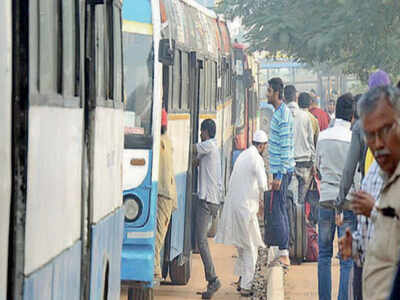
BENGALURU: Fares of state transport undertakings — BMTC, KSRTC, NWKRTC and NEKRTC — are likely to be hiked to stem losses from rising operational costs. Confirming that discussions along similar lines were on, a senior transport department official said: “Fare revision is inevitable, but we haven’t yet decided if it will be applicable to all corporations or if BMTC will be exempted from it. It’s a policy decision to revise fares.”
The proposal, which comes close on the heels of Bengaluru earning the tag of ‘the most traffic congested city in the world’, is likely to further discourage public transport users and add to congestion on roads. In November last year, chief minister BS Yediyurappa said the government would reduce bus fares of STUs to encourage people to use public transport. However, the CM recently backtracked on the promise. Transport minister Laxman Savadi too recently said that there is a ‘demand’ to increase fares.
With skyrocketing operational costs, all STUs are incurring heavy losses. Statistics show that at Rs 349.4 crore, BMTC suffered maximum financial loss in 2018-19, followed by KSRTC (Rs 134.9 crore), NWKRTC (Rs 89 crore) and NEKRTC (Rs 68.2 crore).
A fare increase between 10%-18% has been proposed, said sources.
With state budget round the corner, all four STUs are hoping for a significant allocation to stem losses. According to sources, all STUs had suggested viability gap funding (which supports projects that are economically justified, but not financially viable) from the state government to enhance existing fleet and also expand the same. Currently, STUs are spending about 50% of their outlay on staff wages and 30% on fuel costs. In fact, many of them have already trimmed several schedules to reduce losses.
“The government had exempted only BMTC from paying motor vehicles tax, but it still has to pay property tax and GST. We are hoping for a significant allocation for STUs in the budget,” said an official.
Despite spiralling fuel costs, fares of STUs haven’t been revised since 2014. However, STUs in Karnataka still have one of the highest fares in the country. BMTC’s daily ridership has fallen to 35.8 lakh in 2018-2019 from 51.3 lakh in 2014-15. While a hike of 18% was announced in September 2018, it was reversed by then chief minister HD Kumaraswamy in less than 30 minutes due to public backlash.
Many public transport activists say the move to hike rates could be detrimental as it’ll only increase traffic snarls in the city. “Bengaluru has the highest bus fares in the country. There are thousands of people who actually walk a certain distance because they can’t afford bus fares. When the fares were hiked last time, many people shifted to two-wheelers and illegal transport modes. If we reduce fares, all these commuters will, in all likelihood, move back to buses,” said a statement from Bangalore Bus Prayaanikara Vedike, an NGO.
Experts say making public transport free will reduce traffic congestion, pollution, fuel consumption and offer better quality of life.
The proposal, which comes close on the heels of Bengaluru earning the tag of ‘the most traffic congested city in the world’, is likely to further discourage public transport users and add to congestion on roads. In November last year, chief minister BS Yediyurappa said the government would reduce bus fares of STUs to encourage people to use public transport. However, the CM recently backtracked on the promise. Transport minister Laxman Savadi too recently said that there is a ‘demand’ to increase fares.
TimesView
An upward fare revision will not just be unfair to passengers, but will also make state transport undertakings less attractive. The whole of Metro Phase 2 will be operational only by 2024 and a dedicated suburban rail project is still way off the track. As such, a robust bus transport is the most feasible option to save Bengaluru’s choking roads. Instead of hiking rates, the government should work out other ways to support the fragile STUs. It could even pick a lesson or two from other states dealing with similar concerns. Setting eyes on profit is fine, but not at the cost of losing patronage, which is already shrinking.
With skyrocketing operational costs, all STUs are incurring heavy losses. Statistics show that at Rs 349.4 crore, BMTC suffered maximum financial loss in 2018-19, followed by KSRTC (Rs 134.9 crore), NWKRTC (Rs 89 crore) and NEKRTC (Rs 68.2 crore).
A fare increase between 10%-18% has been proposed, said sources.
With state budget round the corner, all four STUs are hoping for a significant allocation to stem losses. According to sources, all STUs had suggested viability gap funding (which supports projects that are economically justified, but not financially viable) from the state government to enhance existing fleet and also expand the same. Currently, STUs are spending about 50% of their outlay on staff wages and 30% on fuel costs. In fact, many of them have already trimmed several schedules to reduce losses.
“The government had exempted only BMTC from paying motor vehicles tax, but it still has to pay property tax and GST. We are hoping for a significant allocation for STUs in the budget,” said an official.
Despite spiralling fuel costs, fares of STUs haven’t been revised since 2014. However, STUs in Karnataka still have one of the highest fares in the country. BMTC’s daily ridership has fallen to 35.8 lakh in 2018-2019 from 51.3 lakh in 2014-15. While a hike of 18% was announced in September 2018, it was reversed by then chief minister HD Kumaraswamy in less than 30 minutes due to public backlash.
Many public transport activists say the move to hike rates could be detrimental as it’ll only increase traffic snarls in the city. “Bengaluru has the highest bus fares in the country. There are thousands of people who actually walk a certain distance because they can’t afford bus fares. When the fares were hiked last time, many people shifted to two-wheelers and illegal transport modes. If we reduce fares, all these commuters will, in all likelihood, move back to buses,” said a statement from Bangalore Bus Prayaanikara Vedike, an NGO.
Experts say making public transport free will reduce traffic congestion, pollution, fuel consumption and offer better quality of life.
Trending Topics
LATEST VIDEOS
More from TOI
Navbharat Times
Featured Today in Travel
Get the app







